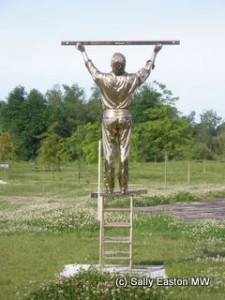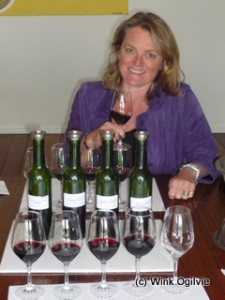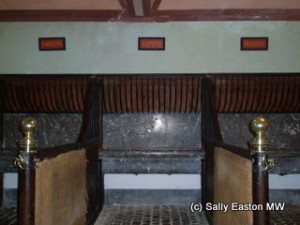Bordeaux wine tourism, part 3 – the left bank
The Médoc – Bordeaux’s left bank – represents much that’s revered in the wine world. The 1855 classification is just for the left bank. Cabernet sauvignon, the king of grape varieties, is king of the left bank. Cabernet sauvignon’s global diaspora starts from the left bank. The low gravel mounds form the terroir that makes the most sought after, and expensive, wines of the world. Neophytes embark on their wine odyssey from Bordeaux’s left bank.
For all that, it is a largely unprepossessing landscape made beautiful and dramatic by pristine row upon row of vines, carpeting the grounds of classic and charming châteaux. And it is remarkably recently that this most traditional of wine regions has begun to embrace wine tourists.

The man who measures clouds, by Jan Fabre
La Winery was one such recent, overtly touristic, project made by Philippe Raoux, who also owns nearby Château d’Arsac. He wanted to bring something of the new world to the region. Certainly the glass and steel greenhouse-style building bears little comparison with those classic châteaux.
Having opening in 2007, it had already attracted some 50,000 visitors in the following year, with a quarter of them estimated to be from abroad. But what is it, with its franglais name? It’s a struggle to classify easily: it’s not a wine château and vineyard with it’s own label. It is a shop with over 1,000 different wines, 40% from Bordeaux, 45% from other parts of France and 15% from other countries. This latter point alone flies in the face of much of vinously parochial France.
It is a restaurant. It is a place, a destination, yet at the beginning of the Médoc, just 25km/half an hour from the city of Bordeaux, where visitors can view modern art, taste wine, hear concerts, learn about wine, and find out their ‘wine sign’.
Art exhibitions are thrice yearly, and there is an audio guided tour in French and English, for the permanent art installations, which takes about 20 minutes.
But the main attraction, since the beginning, has been the wine sign session, which is great fun and takes about an hour. There are three sittings a day, which can be booked in advance, and in English too, with enough advance warning.
The wine sign is good fun for people not knowing too much about wine. It tries to identify, in about an hour, what sort of tastes you like, via a blind tasting of six wines. Depending on how posh the blind wines are, it costs between €16 and €89.
Each person gets a ‘wine sign’ (there are eight categories altogether) and an accompanying booklet explaining your approach to wine. Your wine ‘logo’, with such evocative names as ‘sensuel’, ‘gourmand’, ‘eternel‘, ‘tendance’ and ‘esthète’, can then be matched to bottles of wine in the store.
At the end of 2009, La Winery was the French national winner of a Great Wine Capitals ‘Best of Wine Tourism’ 2010 award for innovative wine tourism (the global award went to Bodegas Muga in Rioja, Spain).

Armelle Falcy-Cruse of Ch.du Taillan, preparing the blending workshop
A couple of years before La Winery opened, and well into the heartland of the Médoc a group of four women friends, château owners and winemakers got together to do something constructive about sharing their passion for their wines.
Martine Cazeneuve of Château Paloumey (Haut-Médoc), Armelle Falcy-Cruse of Château du Taillan, (Haut-Médoc), Marie-Laure Lurton of Château La Tour de Bessan (Margaux) and Florence Lafragette of Château Loudenne (Médoc) formed Les Médocaines at a benign moment in history. They invited tourists into their work during the stunning 2005 harvest, receiving one bus a week. Falcy-Cruse said “In 2005, this was unusual – women demystifying wine, and introducing wine in a fun way.” The novelty value soon worked into a firm fixture.
Falcy-Cruse explained: “our philosophy is for people to have fun. We are all general managers of our wineries, each with our own story. But our target is wine and tourism, it is not for specialists of wine. [Our visitors] want to know about wine, but not to be at school, so we do this in a fun way. It goes against the image of Bordeaux, which is to wear a tie and suit when you come into the chateaux, with lots of protocol.”
Part of their proposition is for tourists to meet with at least two of the owners, along with a visit to two of the four châteaux, which they mix traditional (18th century Taillan and 19th century Loudenne) and modern (the new cellar at Paloumey and the ‘bunker’ of Bessan).
The organised visits have to be booked through the tourism office. Though visitors wanting the traditional visit and tasting can turn up during the week, as usual.
A day’s visit in late Sept/early Oct 2010 will cost €80 all in, including transport from Bordeaux city. Falcy-Cruse said: “we pick grapes for an hour, work at the sorting table, have lunch with real pickers, taste four Médocaines wines. After lunch, we see the vinification, and taste from vat, or taste the grapes or must (juice) from the day. We show our job from the inside, it’s not like a theatre.”
Pre-Christmas visitors to the city might like to do a blending workshop on a Monday morning in November or December for €45. Falcy-Cruse said “we explain about the grape varieties, typicity, how we taste – the colour, the nose, how it’s easier to compare two glasses than to have only one. It’s a very interactive workshop. It’s important for everyone to participate“.

Château Lanessan's stables
For a less active view of the Médoc, horse-drawn carriages in the 264-hectare estate of Château Lanessan are an option. Just 40 hectares are vineyard, and it is the horse-ware that’s the main attraction here. A late 19th century stables of opulence was installed with running water when most human habitations lacked it. Pyrenean marble troughs and brass fixtures are some indication of the level of luxury afforded to the owner’s prized horses. Ten carriages are kept in working order including a Phaeton from 1884.
Visits are available throughout the year, to explore the horse museum, or to do a winemaking and blending tour, but you must do one of these to get half an hour of the vineyards in a horse-drawn carriage, all for €125 for five people. Bookings are directly with the Château, and can be in English, German or Spanish, with enough advance notice.
Read part one here, and part two here.
This article was inspired by a visit to the region in May 2009 sponsored by the CIVB.



